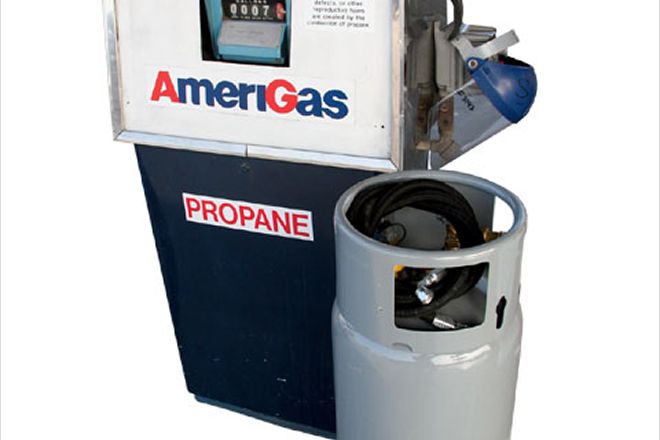
If You've Spied A Trail Rig Or tow rig running propane as a fuel source, you've wondered about its advantages and disadvantages. We've seen a number of respectable rigs spewing those odd fumes and had to experience it for ourselves. We chose to install a dual-fuel kit, having the flexibility of running gasoline as well as propane, supplied by GotPropane.com.
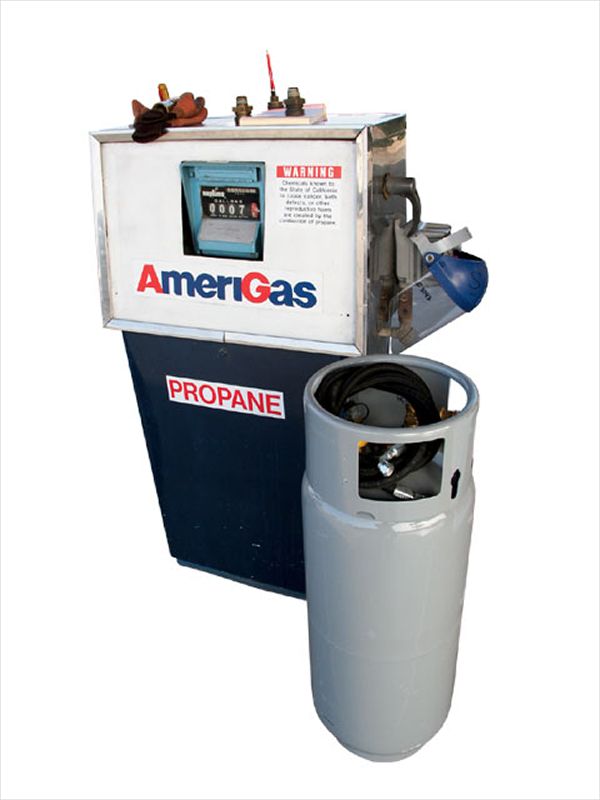
Propane (LP or LPG) is a gas but exists in a liquid state when compressed. While it does not possess the energy that a comparable unit of gasoline does, it burns cleaner and is typically less expensive to purchase. Engines that run on propane have significantly cleaner internals due to propane's low carbon content. Also, since the gas is stored under pressure, vehicles running propane do not require fuel pumps, expensive injectors, or complex mixers such as those found in fuel-injected or carbureted systems. Another benefit is that propane's octane rating varies between 100 and 110, clearly higher than gasoline publicly available. Finally, propane systems either mount on top of, or replace, the carburetor entirely. This eliminates fuel starvation and stalling caused from bouncing or excessive vehicle angles.
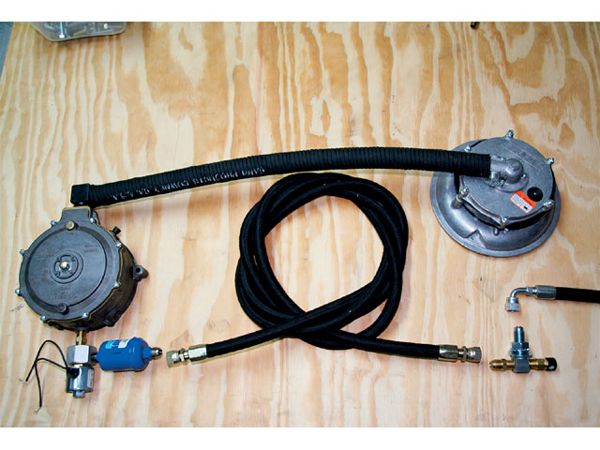 These are the basic components of the dual-fuel system. Liquid fuel delivered from the tank travels through a bulkhead fitting and arrives at the small blue filter. Attached to the filter, an electrically operated solenoid permits fuel flow when in propane mode. The liquid enters the regulator and is heated by the engine's coolant flow. The removal of ambient pressure and the heat from the regulator convert the liquid propane to gas, which travels along the large black hose to the mixer. The mixer is mounted on top of the carburetor where a cable-actuated diaphragm delivers propane gas.
These are the basic components of the dual-fuel system. Liquid fuel delivered from the tank travels through a bulkhead fitting and arrives at the small blue filter. Attached to the filter, an electrically operated solenoid permits fuel flow when in propane mode. The liquid enters the regulator and is heated by the engine's coolant flow. The removal of ambient pressure and the heat from the regulator convert the liquid propane to gas, which travels along the large black hose to the mixer. The mixer is mounted on top of the carburetor where a cable-actuated diaphragm delivers propane gas.
Propane can be ideal for you and your rig, but truly gaining benefits from the conversion will depend on a few factors. First, you must carry more propane on your vehicle than you normally would with gasoline. It is generally accepted that a dual-fuel kit will provide approximate 10 percent lower mileage on propane than a normal gasoline engine. Propane tanks for automotive use are available in two forms-the steel ASME or DOT tank most often found in the back of pickups and the common forklift tank that is available in steel or aluminum. Forklift tanks are easy to dismount and fill, but the largest available only holds 43 pounds of propane, which equates to just 10 gallons of fuel. Finally, any tank used for automotive purposes must be of the type that pulls liquid from the bottom of the cylinder, not vapor from the top as the BBQ or RV tanks do.
Second, propane is not as readily available as gasoline. For you to rely solely upon it as a fuel source would require knowledge of filling station locations and their operating hours, which are not as extensive as those of gas stations.
Finally, an engine running on propane will simply not produce the power that it would on gasoline. While some engines specifically designed for propane have shrunk that gap or perhaps even closed it, the everyday propane-converted engine will produce less power.
If you're still interested, follow along as we install a dual-fuel kit on a 330hp Chevy 350. This kit only applies to carbureted engines with less than 400 hp. Be advised that the mixer and adapter are tall; you must be able to accommodate 61/2 inches of space from the air-cleaner mounting surface to the underside of your hood.
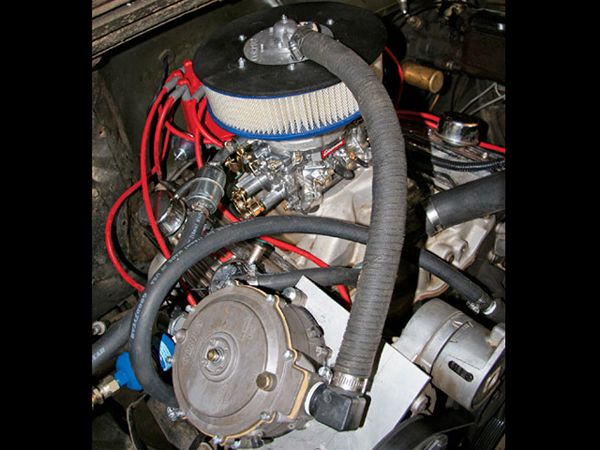
To convert from gas to propane, stop the flow of gasoline by turning off your electric fuel pump or actuating the fuel cutoff solenoid. Wait until the engine uses the last of the gas in the fuel bowl, then pull the cable to actuate the cam within the mixer. The propane will replace the gasoline immediately.
GotPropane states that its propane-only kits provide power nearly identical to carbureted gasoline engines. However, the dual-fuel kit is expected to cost a few horsepower in comparison to the normal gasoline setup.
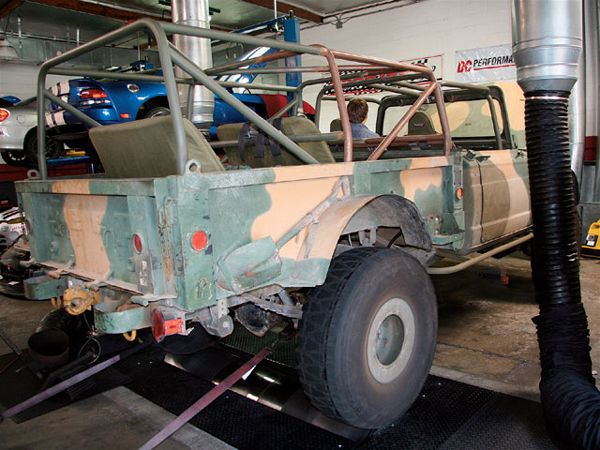
We were able to take advantage of propane's higher octane rating by dialing in more timing advance than we would be able to run with gasoline. To create an "on the go" system, we installed an MSD Adjustable Timing Control so that adjustments could be made from the driver seat. A trip to the dyno at DC Performance yielded the results below. We will, most likely, recover even more power while on propane through additional tuning and dyno testing.
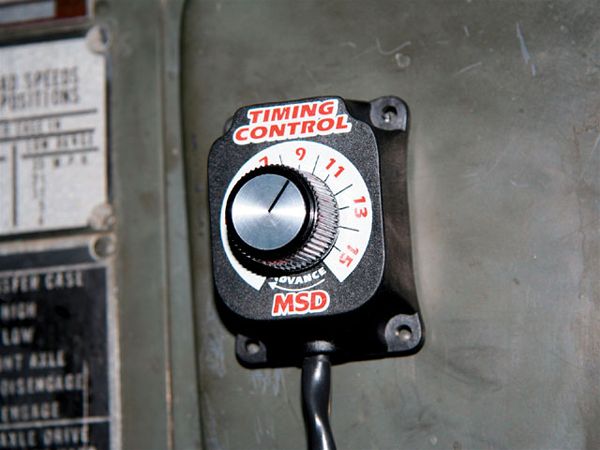
Overall, we enjoy our "poor man's fuel injection" and the cool factor it brings. Propane in our area ranges from $2.30 to $2.99 a gallon at the time of writing, a solid dollar less than gasoline. Fuel starvation off-road is no longer an issue, the horsepower loss is acceptable, and driving a wild, yet environmentally friendly rig just makes you feel good. All those benefits aside, perhaps the most fun derived from the kit is the look on a person's face when you inform them our big ugly ex-Army beast is an ultralow emissions alternative fuel machine.
* Running on propane (factory advance) - 142 hp/206 lb-ft
* Running on gasoline (factory advance) - 152 hp/221 lb-ft
* Running on propane (optimized advance) 143 hp/210 lb-ft
Overall, we enjoy our "poor man's fuel injection" and the cool factor it brings. Propane in our area ranges from $2.30 to $2.99 a gallon at the time of writing, a solid dollar less than gasoline. Fuel starvation off-road is no longer an issue, the horsepower loss is acceptable, and driving a wild, yet environmentally friendly rig just makes you feel good. All those benefits aside, perhaps the most fun derived from the kit is the look on a person's face when you inform them our big ugly ex-Army beast is an ultralow emissions alternative fuel machine.
Running on propane factory advance 142 hp/206 lb-ft Running on gasoline factory advance 152 hp/221 lb-ft Running on propane optimized advance 143 hp/210 lb-ft




